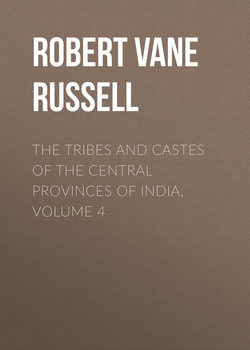Читать книгу The Tribes and Castes of the Central Provinces of India, Volume 4 - Robert Vane Russell - Страница 12
Part II
Articles on Castes and Tribes
Kumhār—Yemkala
Vol. IV
Kumhār
11. The goddess Devi
ОглавлениеDevi signifies ‘the goddess’ par excellence. She is often the tutelary goddess of the village and of the family, and is held to have been originally Mother Earth, which may be supposed to be correct. In tracts where the people of northern and southern India meet she is identified with Anna Pūrna, the corn-goddess of the Telugu country; and in her form of Gauri or ‘the Yellow One’ she is perhaps herself the yellow corn. As Gauri she is worshipped at weddings in conjunction with Ganesh or Ganpati, the god of Good Fortune; and it is probably in honour of the harvest colour that Hindus of the upper castes wear yellow at their weddings and consider it lucky. A Brahman also prefers to wear yellow when eating his food. It has been seen12 that red is the lucky colour of the lower castes of Hindus, and the reason probably is that the shrines of their gods are stained red with the blood of the animals sacrificed. High-caste Hindus no longer make animal sacrifices, and their offerings to Siva, Vishnu and Devi consist of food, flowers and blades of corn. Thus yellow would be similarly associated with the shrines of the gods. All Hindu brides have their bodies rubbed with yellow turmeric, and the principal religious flower, the marigold, is orange-yellow. Yellow is, however, also lucky as being the colour of Vishnu or the Sun, and a yellow flag is waved above his great temple at Rāmtek on the occasion of the fair. Thus Devi as the corn-goddess perhaps corresponds to Demeter, but she is not in this form an animal goddess. The Hindus worshipping Mother Earth, as all races do in the early stage of religion, may by a natural and proper analogy have ascribed the gift of the corn to her from whom it really comes, and have identified her with the corn-goddess. This is by no means a full explanation of the goddess Devi, who has many forms. As Pārvati, the hill-maiden, and Durga, the inaccessible one, she is the consort of Siva in his character of the mountain-god of the Himalayas; as Kāli, the devourer of human flesh, she is perhaps the deified tiger; and she may have assimilated yet more objects of worship into her wide divinity. But there seems no special reason to hold that she is anywhere believed to be the deified buffalo; and the probable explanation of the Dasahra rite would therefore seem to be that the buffalo was at first venerated as the corn-god because, like the pig in Greece, he was most destructive to the crops, and a buffalo was originally slaughtered and eaten sacramentally as an act of worship. At a later period the divinity attaching to the corn was transferred to Devi, an anthropomorphic deity of a higher class, and in order to explain the customary slaughter of the buffalo, which had to be retained, the story became current that the beneficent goddess fought and slew the buffalo-demon which injured the crops, for the benefit of her worshippers, and the fast was observed and the buffalo sacrificed in commemoration of this event. It is possible that the sacrifice of the buffalo may have been a non-Aryan rite, as the Mundas still offer a buffalo to Deswāli, their forest god, in the sacred grove; and the Korwas of Sargūja nave periodical sacrifices to Kāli in which many buffaloes are slaughtered. In the pictures of her fight with Bhainsāsur, Devi is shown as riding on a tiger, and the uneducated might imagine the struggle to have resembled that between a tiger and a buffalo. As the destroyer of buffaloes and deer which graze on the crops the tiger may even be considered the cultivator’s friend. But in the rural tracts Bhainsāsur himself is still venerated in the guise of a corn-deity, and pig are perhaps offered to him as the animals which nowadays do most harm to the crops.
12
Vide article on Lakhera.
